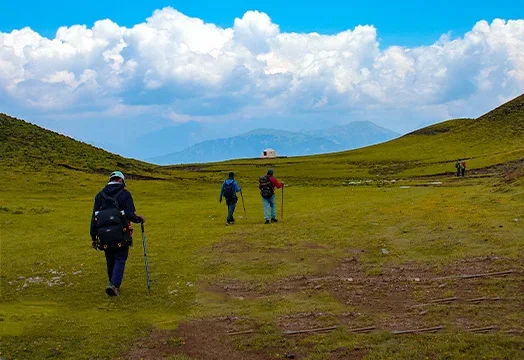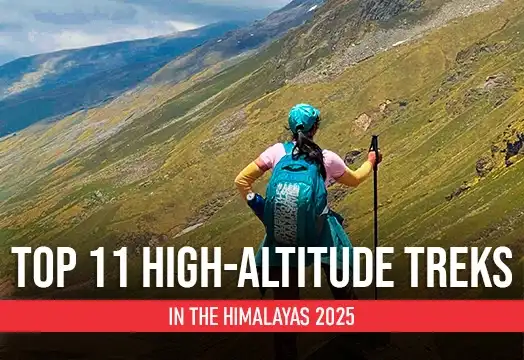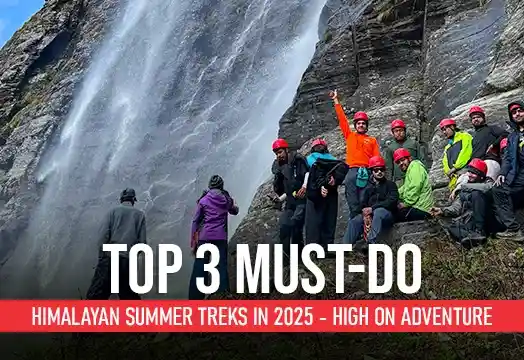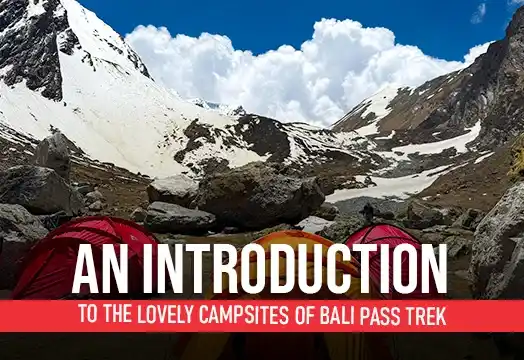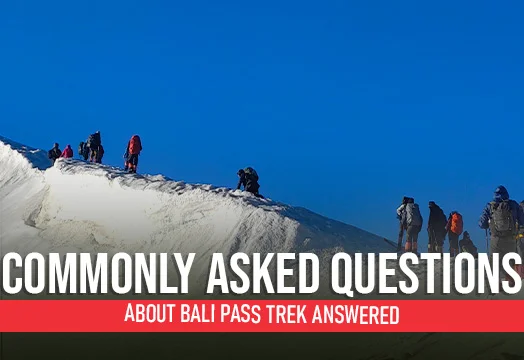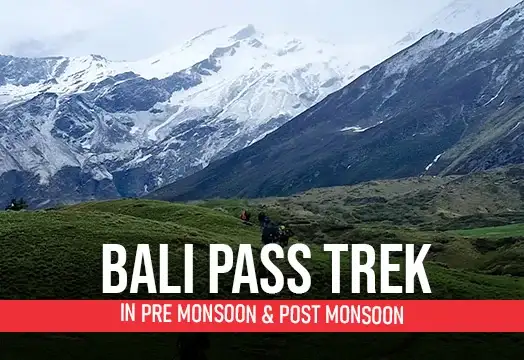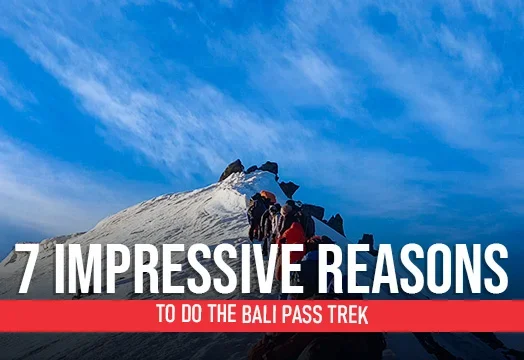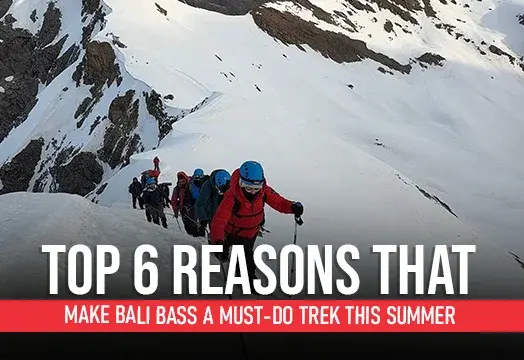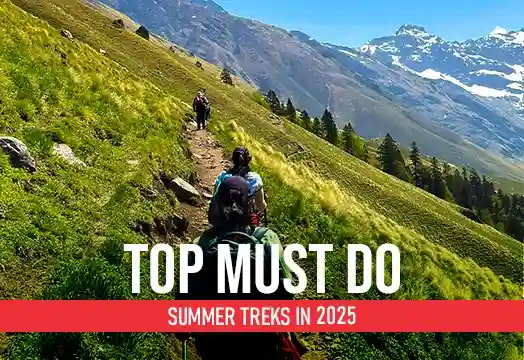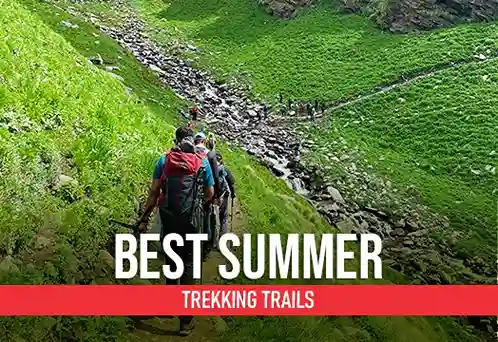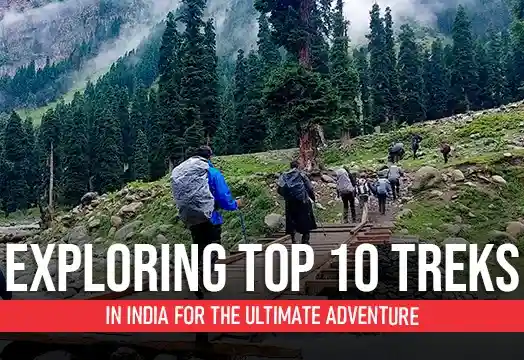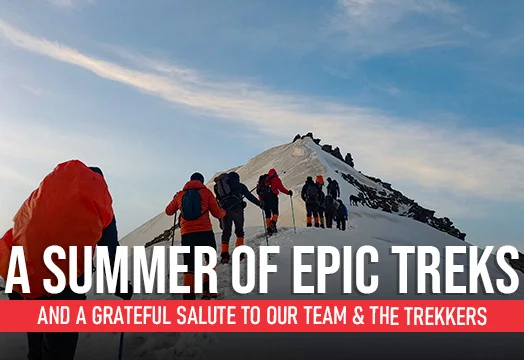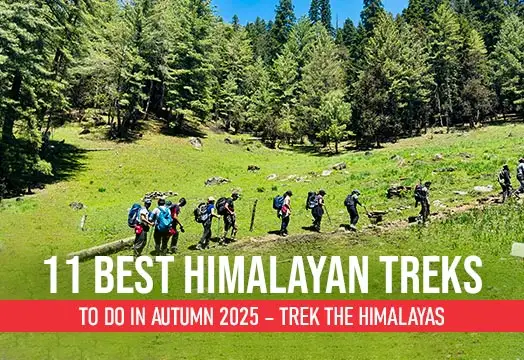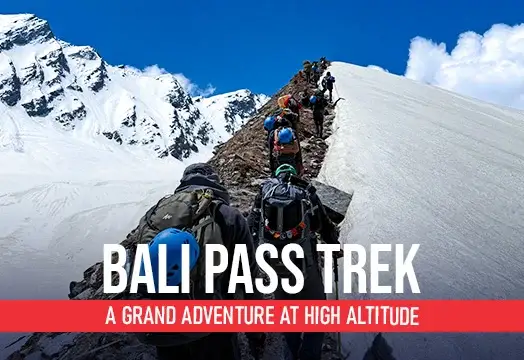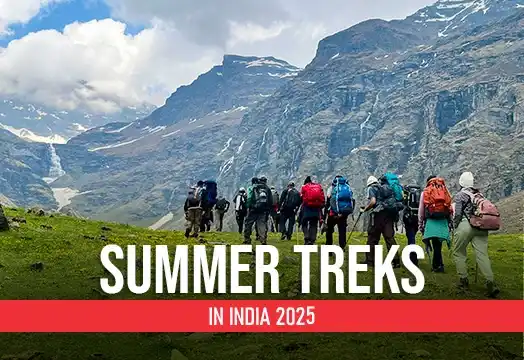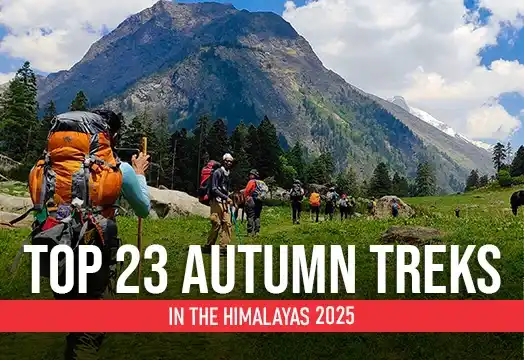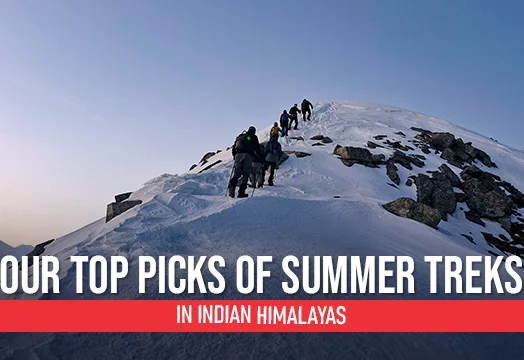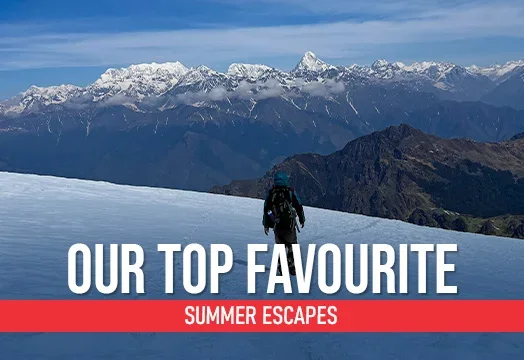Bali Pass Trek

Region
Uttarakhand | India

Duration
8 Days

Max Altitude
16200 Ft.

Trekking Km
56 KM

Grade
Difficult
Get in Touch with Our Trek Expert
91 9917724737 info@trekthehimalayas.comMonday - Saturday: 10 AM to 09.30 PM (GMT +5:30)
Sunday: 10 AM to 05.30 PM (GMT +5:30)
22000 /Person
- May-2026
- June-2026
- September-2026
- October-2026
- 5% GST will be applicable on Trek Cost and Add-ons
- Services Sankri to Janki Chatti.
- Meeting Point( Pickup/ Drop Point ):
Prince Chowk, Dehradun
(If transportation opted from TTH) - Reporting Time: 6:00 am
- Drop Time:6:30 pm to 7:30 pm (Timings are subject to change based on weather and road conditions).
- Please reach Dehradun a day before to avoid any delays.
Add-ons
Insurance 320
- Insurance is mandatory.
- It is available for Indian citizens only.
- Non-Indians have to take insurance on their own.
- If you already have the high altitude trekking insurance, email for a refund after booking.
- The cancellation policy will be implemented in accordance with the trek cancellation policy.
- For more details about insuranceclick here
- + 5% GST will be applicable
Transport 2200
- Transportation Dehradun to Sankari and Jaan ki Chatti to Dehradun is optional.
- Choose add-ons during booking. If missed, log in and add them later.
- Book transportation at least 10 days before the trek.
- Cancellation 4 or more days before the start of the trip results in a 100% cash refund.
- Cancellation less than 4 days from the start of the trip results in a 50% cash refund.
- Cancellations made on the trip date are not eligible for a refund.
- + 5% GST will be applicable
Offload 4800
- Backpack offload is optional.
- Choose add-ons during booking. If missed, log in and add them later.
- Book off-load at least 10 days before the trek.
- For offline bookings at the base camp, a convenience fee of Rs. 5800 applies.
- In the event that you choose to cancel your trek prior to the departure date, you will receive a full refund.
- + 5% GST will be applicable
Single Occupancy Tent 4200
- Single Occupancy Tent is optional.
- Choose add-ons during booking. If missed, log in and add them later.
- Book Single Occupancy Tent at least 10 days before the trek.
- Cancellations made before the trip date will receive a full refund.
- + 5% GST will be applicable
Get in Touch with Our Trek Expert
91 9917724737info@trekthehimalayas.com
Monday - Saturday: 10 AM to 06 PM (GMT +5:30)
Overview
Trek Name: Bali Pass Trek
Days: 8
Adventure Type: Trekking
Base Camp: Sankri
Season:Summer | Autumn |
Month:May | June | September | October |
Country: India
Altitude: 16200 Ft.
Grade: Difficult
Rail Head: Dehradun
Stay: Guest House(Separate male & Female) & Camping (Twin Sharing)
Food: Meals while on trek & Guest House (Veg & Eggs)
Location: Uttarakhand
Distance: 56 Km.
Trail Type: Cross over trail | Start in one valley, traverse the pass, and ends in another valley.
AirPort: Jolly Grant Airport, which is 28 km away from Dehradun
Highlights:
- 5% GST will be applicable on Trek Cost and Add-ons
- Services Sankri to Janki Chatti.
- Meeting Point( Pickup/ Drop Point ):
Prince Chowk, Dehradun
(If transportation opted from TTH) - Reporting Time: 6:00 am
- Drop Time:6:30 pm to 7:30 pm (Timings are subject to change based on weather and road conditions).
- Please reach Dehradun a day before to avoid any delays.
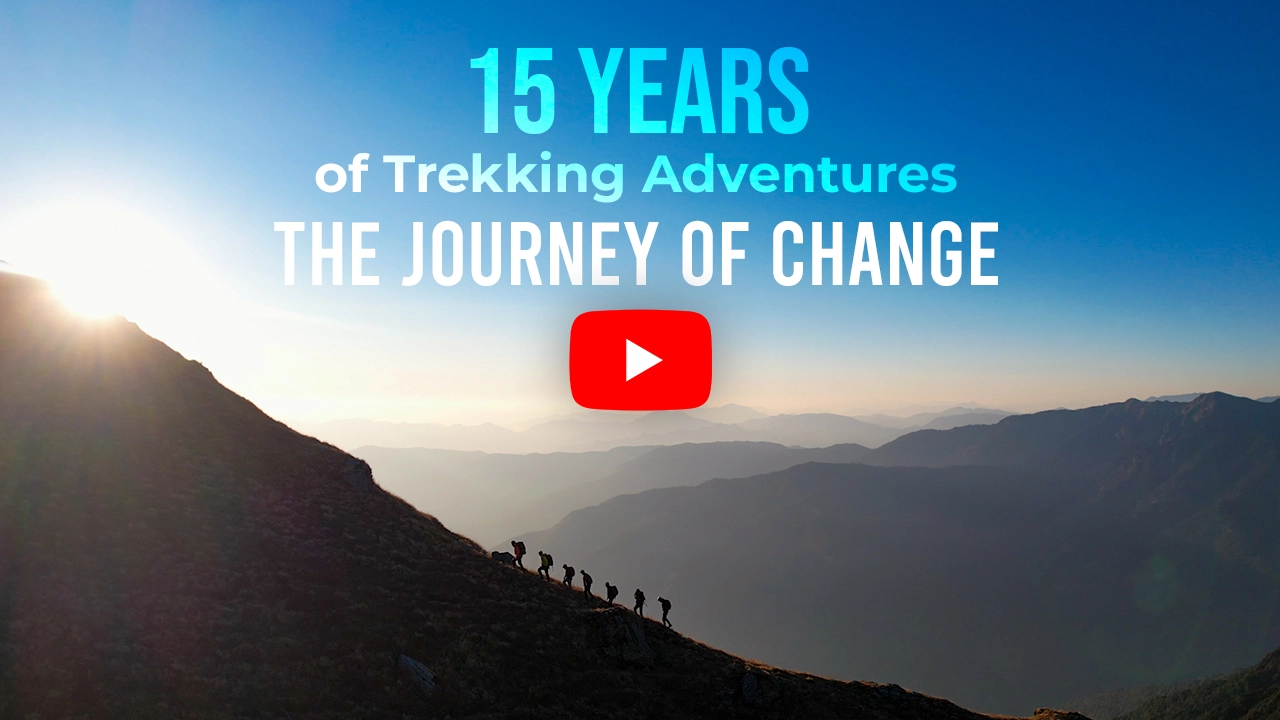
Why is Bali Pass a must-do trek?
- The Bali Pass Trek in Uttarakhand is one of the most thrilling and adventurous treks, offering a wealth of unique experiences to you.
- This trek connects the famous Har Ki Dun Valley with the Yamunotri Valley, taking you through an offbeat route that passes by scenic locations.
- Along the way, you are treated to stunning views of some of the most iconic Himalayan peaks like Swargarohini, Bandarpoonch, and Kala Nag. Watching the sun illuminate these snow-covered peaks in shades of gold and orange at sunrise is a sight that stays with you forever.
- The trek also takes you through ancient villages like Dhatmeer, Dharkot, and Gangad, where you get a glimpse of the unique village culture and the simple, peaceful lifestyles of the mountain people.
- Throughout the journey, you’ll encounter a variety of terrains, dense forests, lush meadows, rocky moraines, snowy stretches, and even river crossings and steep climbs, keeping the trek exciting and diverse.
- Another highlight is trekking through the steep Narma Kandi Ridge, and heading towards bali col campsite.
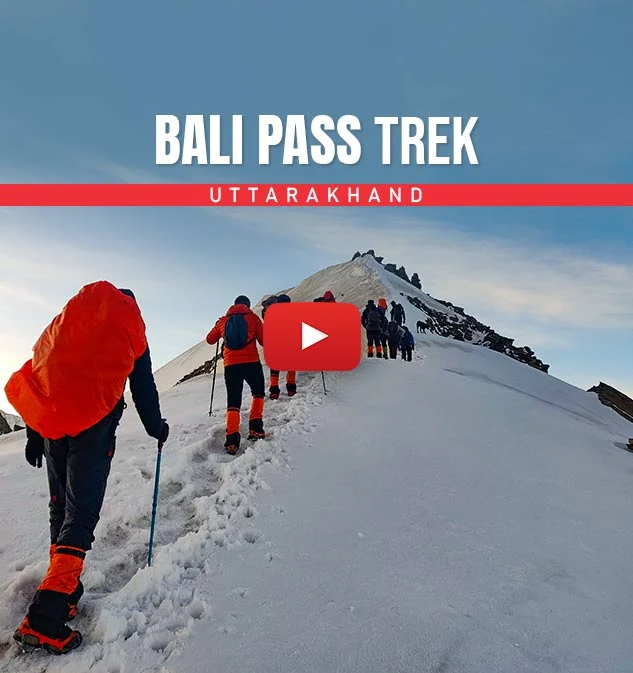
Who Can Participate
- Age Requirement:
- Minimum 16 years
- Fitness Criteria:
- The Trekker should have sufficient stamina to cover 5 km of distance in 30 minutes without stress or 10 km of distance by jogging in 70 minutes without stress.
- If the trekker prefers cycling he/ she should be able to cycle 20 km of distance in 55 minutes.
- Preparation Chart view download
- First-time trekkers are welcome, provided they meet the mentioned fitness requirements.
- If the trekker wants to carry a backpack then he/she should be able to carry a 10-12 kg backpack. If opt Off-load option then the Trekker should be able to carry 3-5 kg backpack.
- If a trekker's BMI is more or less than the normal range (18-26), please consult our Trek Coordinator before booking.
Loved it? Do it again for free!!!
At Trek The Himalayas, we understand that things don’t always go as planned. If you couldn’t complete your trek or just want to experience it once more, we’re giving you a wonderful opportunity – the chance to do the trek again without having to pay the trek fee again.
Pay a one-time fee to select your favourite trek, and you can repeat it as many times as you want within 5 years.
Terms and Conditions:
- The offer is valid for 5 years from the trek departure date.
- Participants are not required to pay the trek cost again, but they will need to cover transportation, insurance, and trek permit costs.
- This offer is non-transferable and is only applicable to TTH's limited fixed departures.
- The offer does not apply if the participant has received a refund, a voucher, or a transfer to another trek that has been used previously.
- The offer will be activated once the participant reaches the trek base camp.
- This is not an offer linked to any purchased package; rather, it is an initiative extended by TTH out of goodwill, without any cost to the trekkers.
- Trek The Himalayas reserves the right to cancel this offer at any time, in case of:
- Disobeying the safety regulations, trekking rules, or the code of conduct
- Black listing due to bad behavior, payment issues, or providing inaccurate information
- Anything that would damage the brand or reputation of TTH
- In order to rebook, just fill in our booking form online or call our team.
Bali Pass Trek Itinerary
Dehradun to Sankri (Drive)
- Altitude Sankri: 1,950 m/ 6,400 ft.
- Drive: 200 km | 9-10 hrs.
- Stay Guesthouse: Twin or triple sharing.
Our journey starts at Dehradun, where we will pick you up from the Dehradun Railway Station early in the morning and drive to Sankri Village in Uttarkashi district of Uttarakhand. Sankri is the base camp for our trek. Located in Govind National Park, Sankri is about 220 km away from Dehradun.
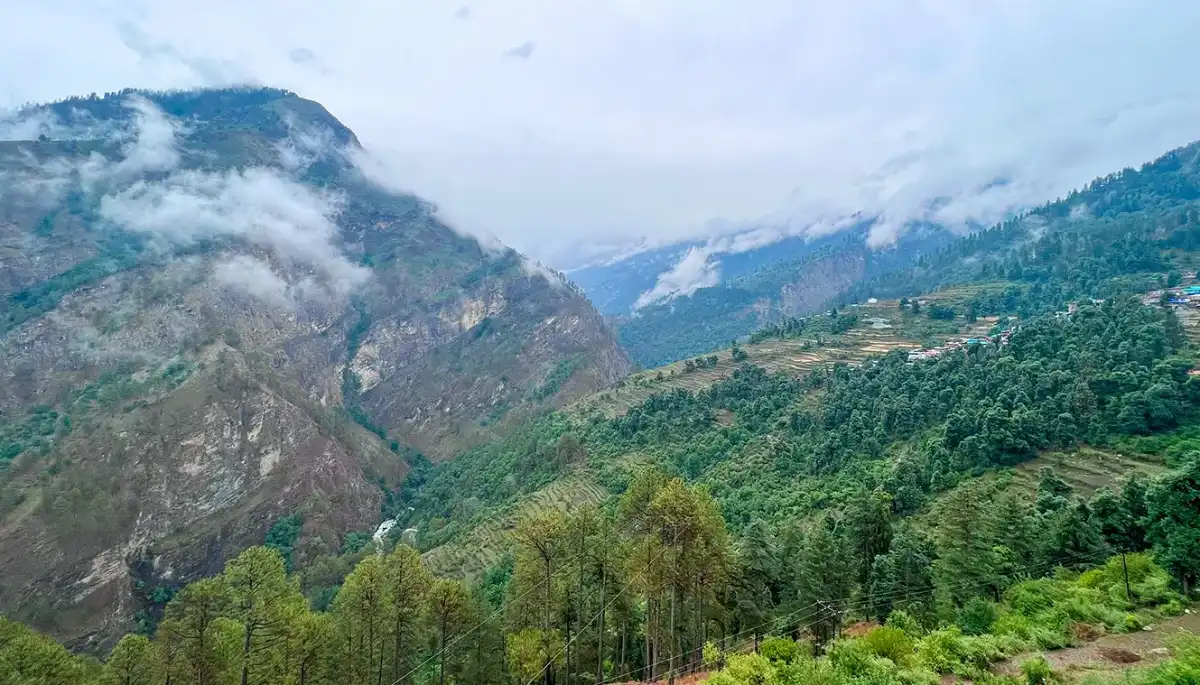
Along our route, we will cross scenic places like Mussoorie, Kempty Falls, etc., and villages like Damta, Netwar, Purola, and Mori. In the first part of the route, you will cross through the beautiful hill station of Mussoorie, and in the middle part drive along the pristine clue-green water of the Yamuna the latter half of the journey, you will pass through coniferous forests and the meandering Tons River flowing side by side.
Purola is the last ATM point on our trip, so if you want to withdraw cash, you can do it here. Once we reach the Mori checkpost, you will be asked for Aadhar or similar ID proof at the check post. Keep them ready. After Mori, it is a short drive to Sankri, where we will stay for the night. The stay is arranged in a hotel/guesthouse. We will reach Sankri by late evening and after freshening up in the hotel, you can enjoy the splendid views of the setting sun over the Himalayan peaks. Relax in your guesthouse and you can later head out to explore the village and have some delicious local cuisines in the Dhabas.
Sankri to Seema via Dharkot
- Altitude:
- Seema: 2,600 m/ 8,500 ft
- Dharkot: 2,400 m/ 8,000 ft
- Trek Distance (Dharkot- Seema): 10 km | 6 - 7 hr.
- Drive Distance (Sankri - Dharkot): 24 km | 2 hrs.
- Accomodation Tent (Twin sharing).
Today, you will start your day with a warm and hearty breakfast, surrounded by stunning views of the majestic mountains. The crisp morning air and serene surroundings will set the perfect mood for the adventure ahead. After enjoying your meal, it’s time to embark on today’s journey.
You’ll first drive from Sankri to Dharkot. The drive itself is an experience, as the winding mountain roads offer views of towering peaks and lush valleys. You’ll feel the cool, refreshing breeze of the mountains, making the ride even more enjoyable. As you approach Dharkot, the last motorable point, the anticipation for the trek ahead begins to build.
From Dharkot, your trek to Seema village begins. The trail begins with a well-defined path and takes you through vibrant forests filled with a variety of trees including Cedar and Pine, Maple, Oaks and lush greenery. The peaceful sound of nature will accompany you, from chirping birds to the gentle rustling of leaves. Along the way, you’ll come across Gangar village, a charming settlement with traditional wooden houses that reflect the region’s unique architecture. Take a short break here to admire the beautiful valley views before continuing your ascent.
As you arrive in Seema village, the peaceful surroundings offer a perfect place to unwind. Here you will settle in for the night and a warm and delicious dinner will be served, providing a comforting end to the day's journey. As you relax, take in the serene surroundings and let the mountain air refresh you. With the gentle sounds of nature around, rest well and recharge for the adventures that lie ahead.
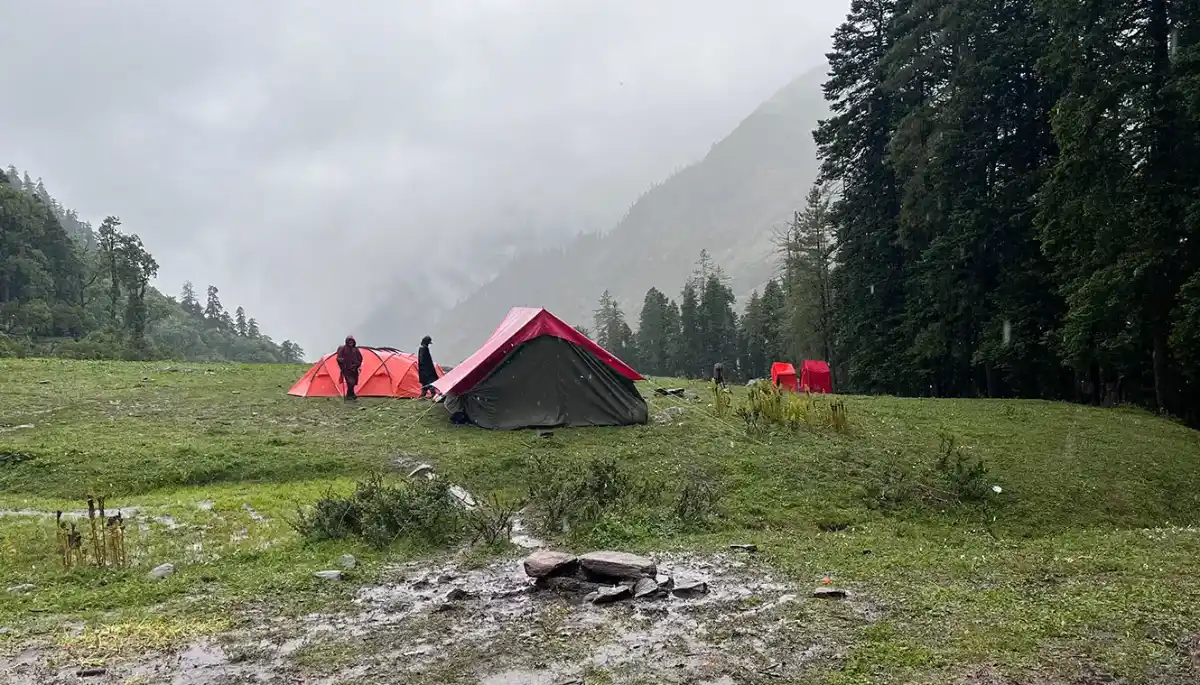
Seema to Devsu Bugyal
- Altitude: 3,100 m/ 10,200 ft.
- Altitude difference: 500 m/ 1,700 ft.
- Trek Distance: 5-6 km | 5-6 hr.
- Accomodation: Tent
Today we will trek along the Supin River to Devsu Bugyal and walk through Devsu Bugyal meadows. We will trek along the Supin River and the river will be on our left side. The path may also be a little slippery toward the end so be cautious.
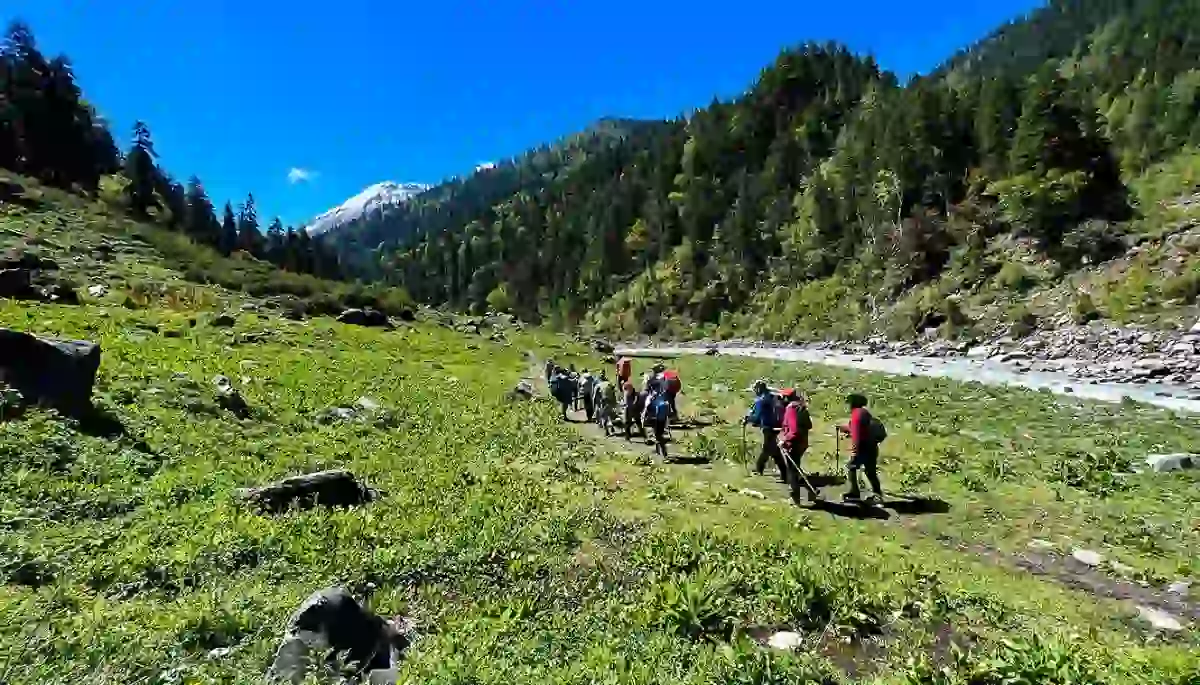
The trail begins with Supin River on the left and while ascending, the path soon becomes steep as you get closer to Devsu Bugyal, climbing up, you will get the views of Osla Village behind you and as you enter the Ruinsara Valley, the path becomes filled with boulders adding more challenge to your trek. 30 minutes further walk will bring you into Devsu Bugyal meadows and the meadow stretches for about 2 km. We will rest here for a while appreciating the natural beauty.
The Devsu Bugyal meadows are set amidst the Ruinsara forest and while ascending towards Devsu Bugyal, you will see a variety of Himalayan wildflowers and foliage. The forest is also home to many bird and animal species as well and hiking through the forest, you may even spot some rare species along the way.
Devsu Bugyal to Ruinsara Tal
- Altitude: 3,600 m/ 11,800 ft (Ruinsara Tal).
- Altitude difference: 500 m/ 1,600 ft.
- Trek Distance: 9 km ( 5 - 6 hrs approx.)
- Accomodation: Tent
Today is an exciting day of our trek as you will trek to the beautiful glacial lake, Ruinsara Tal. It's a 9 km trek to Ruinsara Tal and after walking for about 4 to 5 hours you will arrive at the lake.
The lovely Ruinsara Lake is surrounded by meadows and Rhododendron blooms, which amplify its beauty. The campsite is wonderfully nestled in a location where on one side is the Ruinsara Lake and on the other side the Supin River. The views from the campsite are equally as beautiful as the lake. You will see Yamuna Kanta on the southwest side, the pass that will take you to Yamunotri, the source of the Yamuna River. On the east lies the majestic mountains, the Bandarpunch peak, and Dhumdhar Kandi Range, and on the south-east, you can see Kala Nag and White peak.
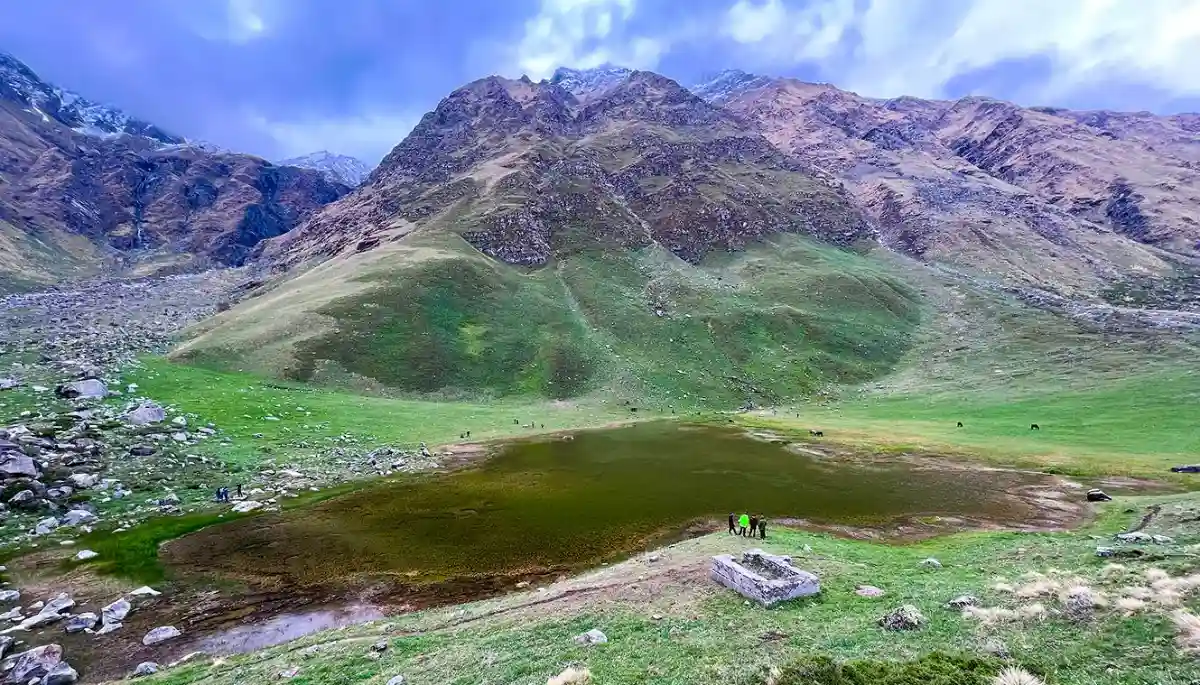
You can spend the evening at your leisure and explore the area, take some beautiful pictures. At night we will enjoy a hot dinner at the campsite and retire in your tents for a good night’s sleep.
Ruinsara Tal to Odari
- Altitude: 4,000 m/ 13,100 ft.
- Trek Distance: 4 km | 3- 4 hrs.
- Accomodation: Tent
Today is a short trek from Ruinsara Tal to Odari, about 4 km. It will take about 4 to 5 hours to reach Odari. The trek starts with a descent to the Supin River along with dense vegetation and after crossing the river through a bridge, you will ascend to a small meadow and continue our trek in the south-east direction along the river. A further walk for about three hours will bring you to Odari.
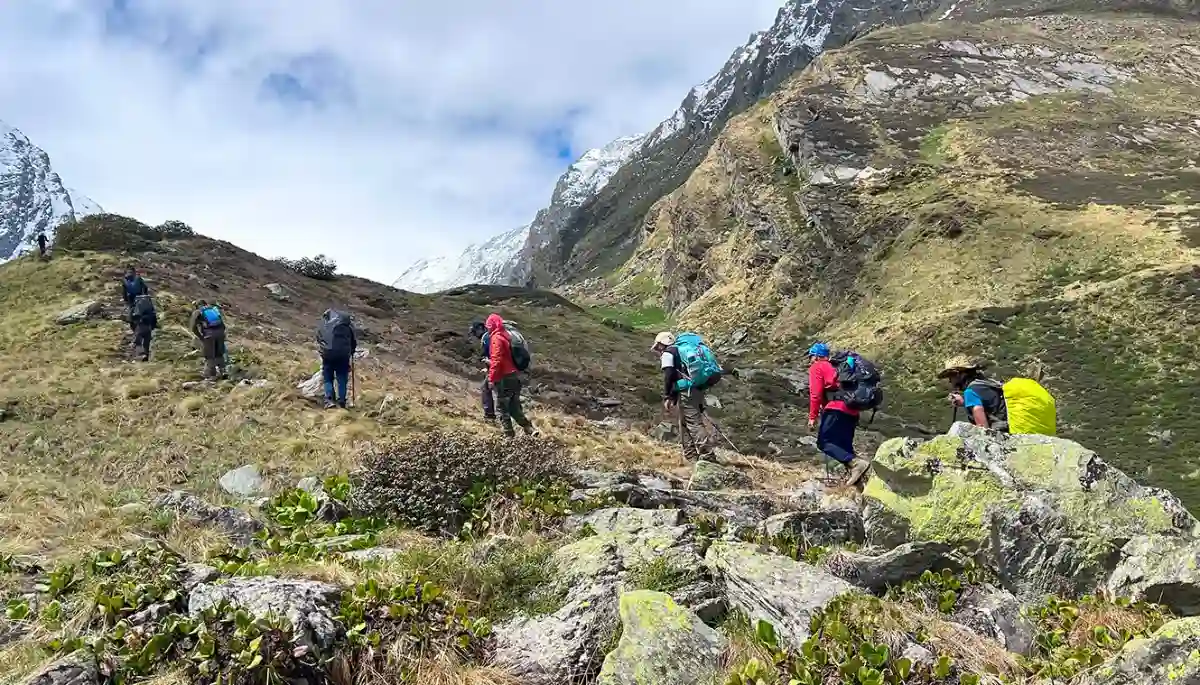
The name Odari means naturally made rock cave and as per the folklore, the locals believe that Sugreevs brother, Bali had spent a night here at Odari. Odari campsite also offers some stunning views of Swargrohini peaks. If you are lucky, you might find evidence of the rare Himalayan mountain bear as well. The camp is set in a unique location with the beautiful valleys below you and the Bali Pass behind you.
After lunch, the trek leader will give you a briefing and some training that will be useful when you trek toward the summit. Have proper food and sleep well so that you have good energy. Being a high-altitude base camp, the temperatures at night can fall to sub-zeros and as such you need to take appropriate measures to warm yourself.
Odari to Bali col camp
- Altitude: 4,600 m/ 15,100 ft.
- Trek Distance: 5 km | 6 - 7 hr.
- Accomodation: Tent
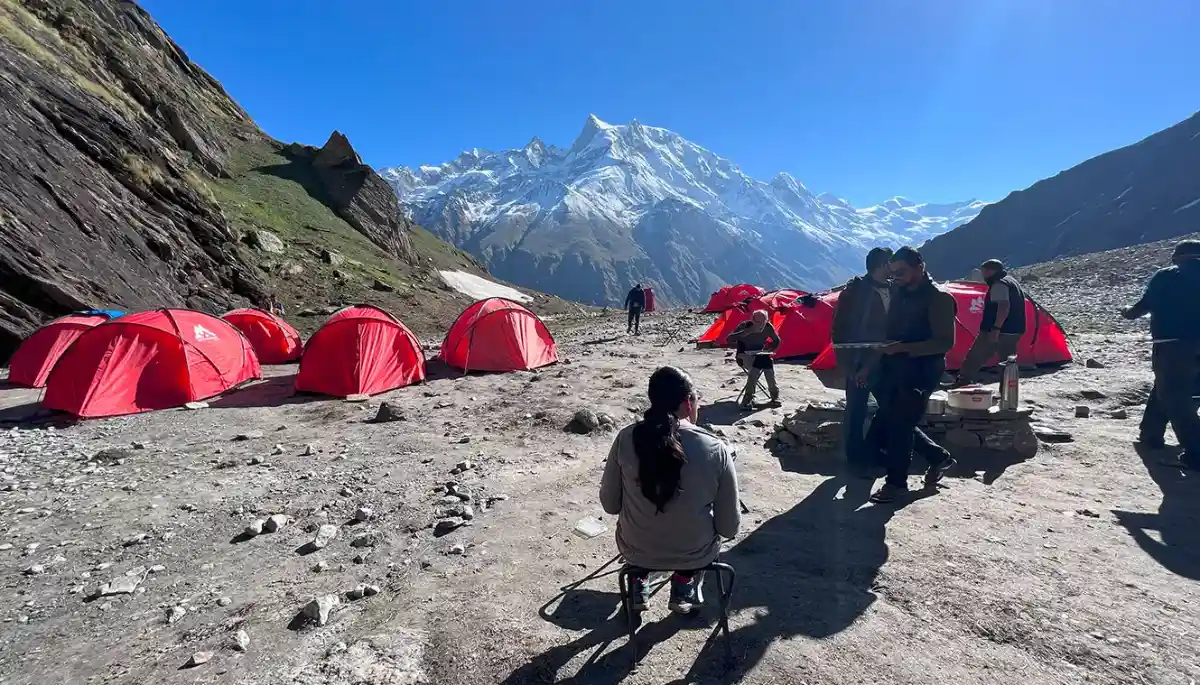
The trek from Odari to Bali Col Camp is 5 km and the camp is situated at an altitude of 15,100 ft. Begin the trek by heading southwest towards the base camp. You will walk along a mountain ridge to reach the base camp. The trek difficulty gradually increases from Odari as you get closer to the Pass. From Odari camp, carry at least 2 liters of water with you as there are no water sources on the way to our next campsite.
Today we will be camping at an altitude of 15,100 ft so you should be properly hydrated and keep yourself as active as possible to avoid the chances of AMS (Acute Mountain Sickness). The ridge that we climb up is sharply inclined at 60 degrees, which can make for a strenuous climb even though the distance is short. The temperature also rapidly drops and acclimatization takes longer at such heights, so take all the appropriate measures and follow your trek leader’s advice. Sleep early and get as much rest as possible to trek to the summit the next day.
Bali col camp to Lower Dhamni via Bali Pass
- Altitude:
- Bali Pass: 4,950 m/ 16,200 ft.
- Lowar Dhamni: 3,350 m/ 11,100 ft.
- Trek Distance: 14 km | 10 - 11 hrs.
- Accomodation: Tent
Today is the summit as we will trek to the highest point of the trek touching an altitude of 16,200 ft. After making the summit, we will also descend to our next campsite at Lower Dhamni, which is at an elevation of 11,100 ft. Today’s trek will be the longest and the most challenging so far. Beginning our day early in the morning, we will head southeast towards the Pass.
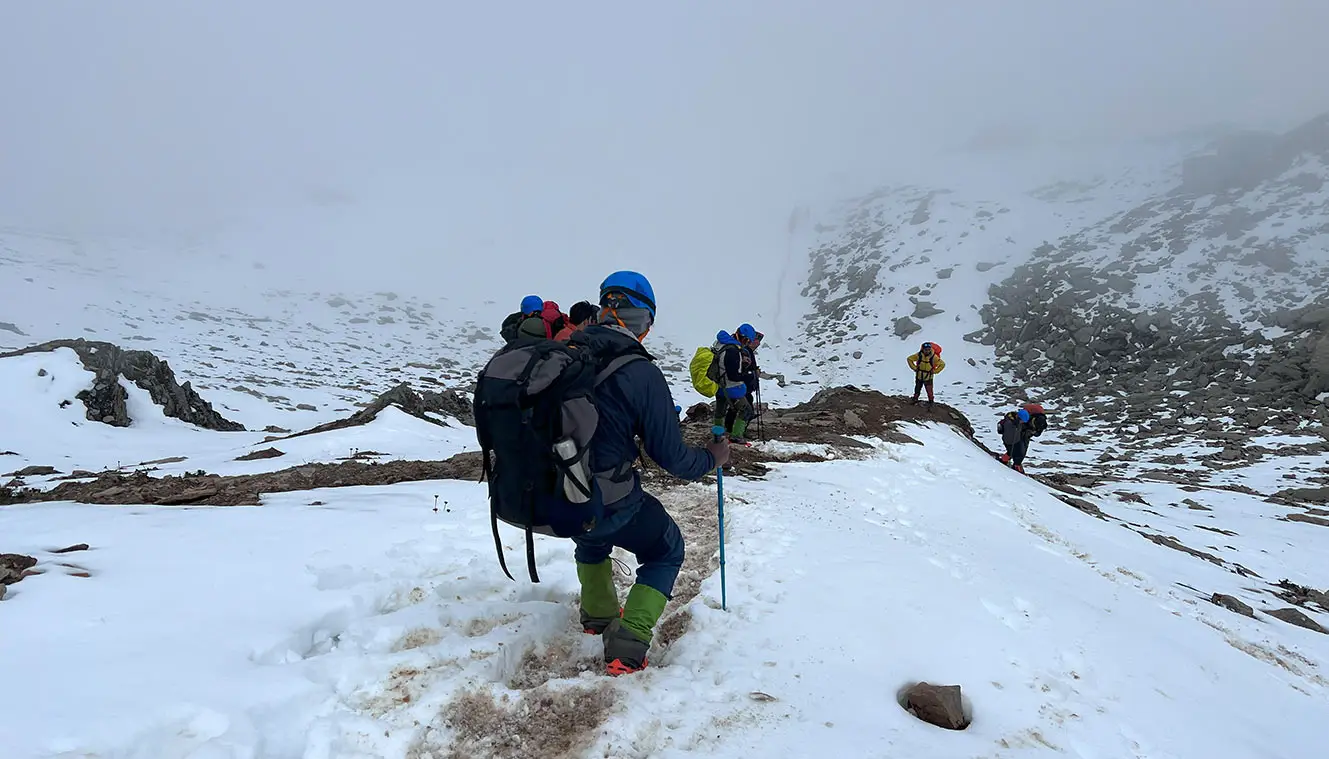
The entire trail is filled with snow and you will have to use the skills that your trek leader taught earlier to maneuver through the snow. From the base camp, it takes about 2 to 3 hours to reach the summit and once you are at the top, you can enjoy some of the most stunning mountain views that you have ever witnessed.
Get 360-degree views of Himalayan peaks like Bandarpoonch, Swargrohini, and other ranges of the Garhwal Himalayas from the top and you will also get views of the Yamunotri Valley from here. After spending some time at the summit, we will descend to the Lower Dhamni campsite.
The trail to the summit is quite difficult and Bali Pass Summit is quite narrow itself, 10 feet long and 30 feet wide and cannot accommodate more than 20 to 30 people at a time. Overcoming all the challenges when you make it to the summit fills you with a sense of accomplishment and pure joy and the difficult climb ends up becoming extremely rewarding.
The descent to Lower Dhamni is quite challenging. Even though we are moving downhill, the descent is very steep and technical. Its almost a vertical path, so you need to be very very careful. Also, the path is full of big stones and loose stones, which adds to the difficulty. If there is snow, then it will further add to the challenge.
The difficult path does not end here, after the steep descent we have to walk on a very narrow path, which is as narrow as 6 inches in some places, so follow your trek leader and heed their advice as you climb down to Upper Dhamni. After such a challenging descent, we will rest for a while at Upper Dhamni before resuming our trek.
The trek down from Upper Dhamni to Lower Dhamni is not marked and is also quite confusing as it runs in a zig-zag maze. It is advised that everyone sticks close together and observe your trek leader and the guiding team. After crossing the meandering path, the trail flattens out and is now easily visible. After trekking for about 2 km through a forest cover, you will arrive at your Lower Dhamni campsite. After a long and tiring day, you can rest in your tents to recuperate.
Lower Dhamni to Janki Chatti and drive to Dehradun
- Altitude: 2,600 m/ 8,500 ft. (Janki Chatti)
- Trek Distance (Lower Dhamni - Janki Chatti): 8 km | 4 - 5 hr.
- Drive Distance (Janki Chatti - Dehradun): 170 km, 7-8 hrs approx.
Today is the final day of your trek and the culmination of your journey. The ascent to the Yamunotri Temple is relatively easier compared to the previous days. You’ll start on a mud trail that gradually merges into a cemented pathway leading up to the temple. The remainder of the route follows this paved trail.
At Janki Chatti, transportation has been arranged to take you back to Dehradun. We’ll leave early from the campsite to ensure a timely return. With a beautiful offbeat trekking experience and lasting memories, you'll head home after an incredible adventure. As you make your way back, you'll pass through the charming villages of the Yamunotri Valley, offering a glimpse into the local culture and daily life nestled in the mountains.
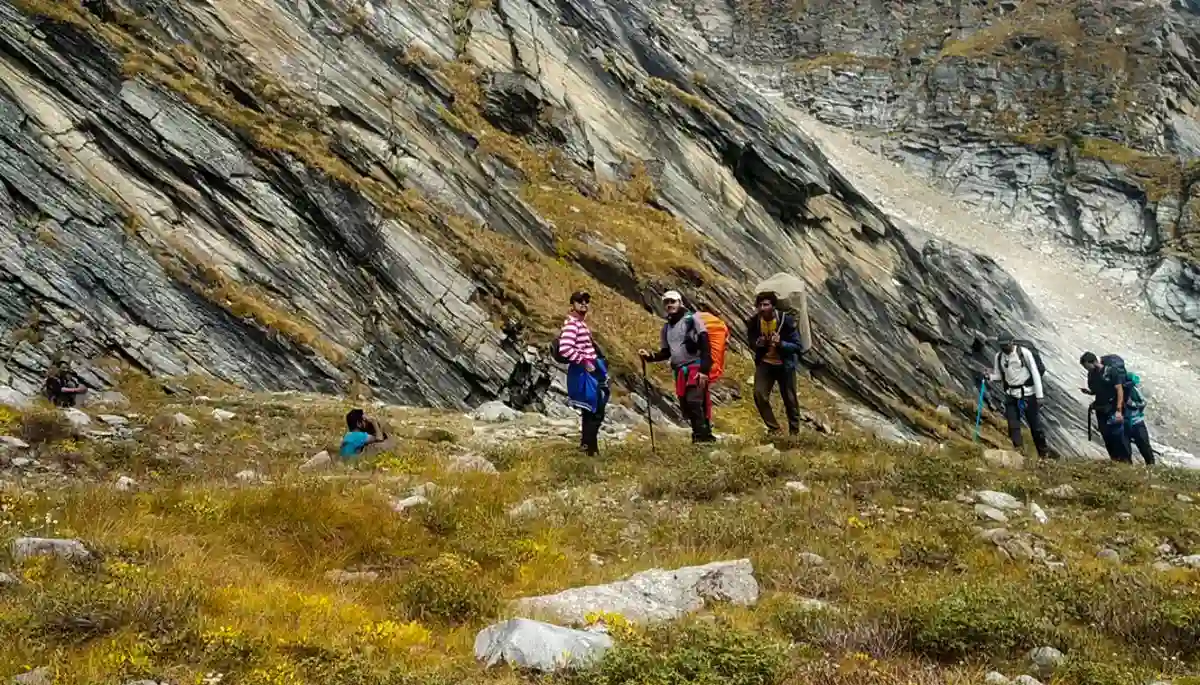
Note:
- Keep a buffer day in your travel plan.
- If buffer day is not used in the travel then it can be used to Explore Dehradun/Mussoorie.
- Distance, Altitude, and Trekking hours are approximate and rounded off.
- Keep the original and copy of ID proof handy.
- Come one day early if planning to come by flight.
Day-1: Dehradun to Sankri (Drive)
- Altitude Sankri: 1,950 m/ 6,400 ft.
- Drive: 200 km | 9-10 hrs.
Day-2: Sankri to Seema via Dharkot
- Altitude:
- Seema: 2,600 m/ 8,500 ft
- Dharkot: 2,400 m/ 8,000 ft
- Trek Distance (Dharkot- Seema): 4 km | 3-4 hours.
- Drive Distance (Sankri - Dharkot): 24 km | 2 hrs.
Day-3: Seema to Devsu Bugyal
- Altitude: 3,100 m/ 10,200 ft.
- Trek Distance : 5-6km | 5-6 hr.
Day-4: Devsu Bugyal to Ruinsara Tal
- Altitude Ruinsara Tal: 3,600 m/ 11,800 ft.
- Trek Distance: 9 km | 5 - 6 hrs.
Day-5: Ruinsara Tal to Odari
- Altitude: 4,000 m/ 13,100 ft.
- Trek Distance: 4 km | 3- 4 hrs.
Day-6: Odari to Bali col camp
- Altitude: 4,600 m/ 15,100 ft.
- Trek Distance: 5 km | 6 - 7 hrs.
Day-7: Bali col camp to Lower Dhamni via Bali Pass
- Altitude:
- Bali Pass: 4,950 m/ 16,200 ft.
- Lowar Dhamni: 3,350 m/ 11,100 ft.
- Trek Distance: 14 km | 10 - 11 hrs.
Day-8: Lower Dhamni to Janki Chatti and drive to Dehradun
- Altitude: 2,600 m/ 8,500 ft. (Janki Chatti).
- Trek Distance (Lower Dhamni - Janki Chatti): 8 km | 4 - 5 hr.
- Drive Distance (Janki Chatti- Dehradun): 170km | 7-8 hr.
Note:
- Keep a buffer day in your travel plan.
- If buffer day is not used in the travel then it can be used to Explore Dehradun/Mussoorie.
- Read the article Things to do in Dehradun.
- Distance, Altitude, and Trekking hours are approximate and rounded off.
- Keep the original and copy of ID proof handy.
- Come one day early if planning to come by flight.
Bali Pass Trek Graph
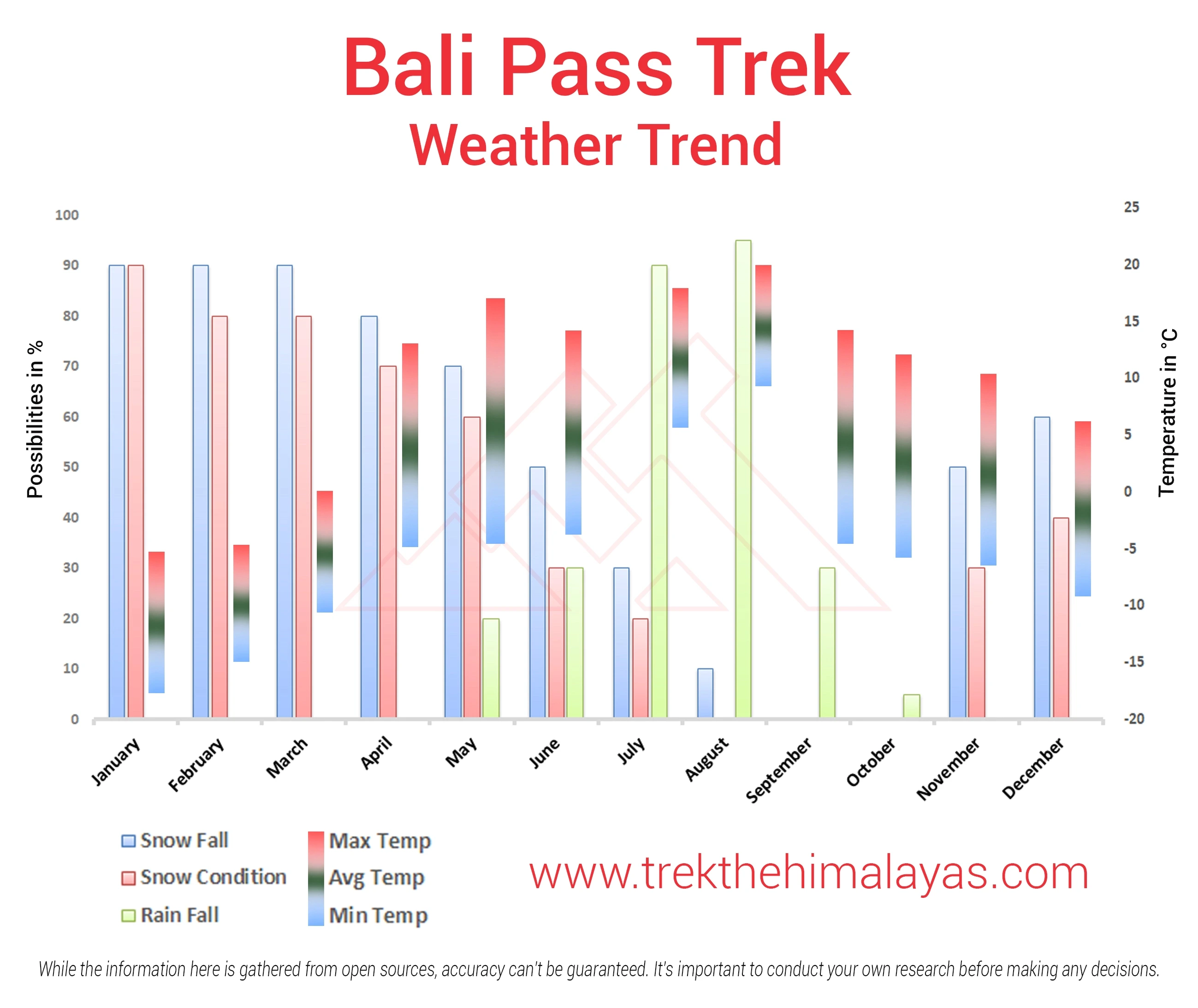
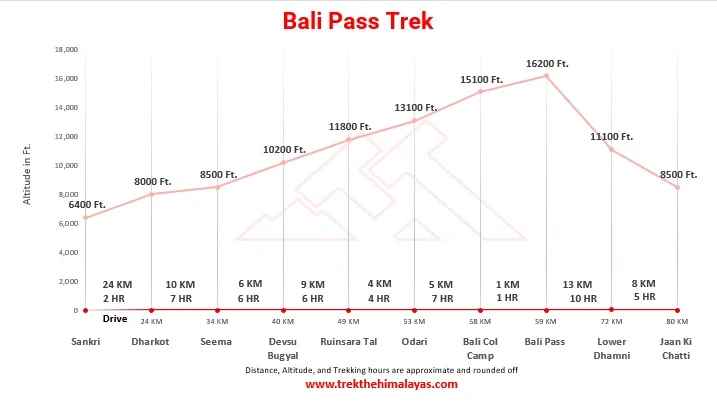
_11zon.webp)
- Pulse rate at rest must be in between (60 to 100 beats per minute).
- Blood Pressure Reading must be in between (DIASTOLIC 75 – 85, SYSTOLIC 100 - 130 mm Hg).
- Respiratory rate at rest must be in between (12 to 20 breaths per minute).
- Should not have Liver and kidney issues.
- Should not have Diabetes Mellitus, Bronchial Asthma, Heart problems, Hypertension, etc.
- No pacemaker implant.
- People with Sinus issues, Epilepsy please contact to trek coordinator before booking the trek.
- If your BMI is not normal, Please contact our Trek coordinator before Trek booking.
Medical & Disclaimer Form (Mandatory Documents) Click here to download Medical & Disclaimer Form
Government employees can avail the benefit of Special Casual Leave (SCL) when they join us for a trekking expedition. As per Pay Commission guidelines, up to 30 days of Special Casual Leave can be availed in a calendar year for trekking or mountaineering expeditions conducted through a registered organisation.
Trek The Himalayas is a registered adventure tour operator with the Indian Mountaineering Foundation (IMF) and the Ministry of Tourism (MoT), making your trek eligible for SCL benefits.
To apply, email us at info@trekthehimalayas at least 20 days before the trek departure date, with the following details:
- Trek name and trek date
- Booking details
- Full name
- Designation
- Department and department address
This benefit is exclusive to Indian Government employees and is applicable only for treks within India.
- Junior trekkers (below 15 years) should have a company of parents/guardians.
- Trekkers between 15 to 18 years can come solo with the disclaimer form signed by parent/guardian.
- Medical & Disclaimer Form (Mandatory Documents) Click here to download Medical & Disclaimer Form
Important Links
- Mandatory Documents to Bring on A Trek Click Here.
- How to pay Add-ons, Submit Medical Forms, and Dietary Preferences Click Here to watch Video
How To Reach
Pick-Up Information
- It is essential for everyone to arrive at Prince Chowk, Dehradun (06:00 am).
- Once you have reached Dehradun, TTH will manage the rest of your travel arrangements, if you have opted for TTH's pick-up service, you can select this option during the booking process by adding it as an add-on.
Options to Reach Dehradun
First, you can arrive at Delhi, Dehradun Airport or Chandigarh. The journey from these locations to Dehradun is explained below.
1. Take an overnight train from Delhi to Dehradun.
2. Take a bus to Dehradun ISBT from Delhi Kashmiri gate ISBT or Chandigarh Sector 17 Bus stand, and then take local transport to the pickup point (Prince Chowk).
Delhi to Dehradun - 250km | 6hr.
Chandigarh to Dehradun - 220km | 5hr
The distance from the Dehradun Bus Stand (ISBT) to the Railway Station is 6 km, without traffic, it will take 15 minutes.
( We always recommend to go for the govt. Buses over the private ones outside the bus station as based on the experience we have found that there are very high chances of delay involved with private buses. Also, govt. Buses are always more reliable. Whichever bus you choose, just make sure to reach Dehradun at least by 05:30 am positively. )
3. Take a flight to Dehradun airport (Jolly Grant Airport), then from the Airport to Prince Chowk, Dehradun Distance is 30km and it will take around 1 hr( if coming by flight then reach one day early).
Drop-Off Information
- The designated drop-off point is Prince Chowk, Dehradun.
- Arrive in Prince Chowk by 6:30 to 7:30 pm.
- Please consider planning your subsequent travel arrangements after 9:00 pm.
- The distance from the Railway Station to Dehradun Bus Stand (ISBT) is 6 km, it will take approx 25 minutes.
- The distance from Railway Station to Dehradun Airport is 30km, it will take approx 1hr.
- It's highly advisable to keep a buffer day in your travel plan. If the buffer day is not needed, it can be used to explore Dehradun/Mussoorie/Rishikesh.
( If you prefer to travel independently to Base camp and don't want to take TTH's pick-up service, you can either take a government bus or book a private cab from Dehradun. Your trek coordinator will provide guidance on how to arrange for the bus or cab booking. )
TTH offers comfortable transportation through Tempo Traveler, Bolero, or equivalent vehicles. If you wish to upgrade your mode of transportation, please contact your trek coordinator for further assistance.
.webp)
.webp)
.webp)
Cost Terms
Inclusion
1. Accommodation (as per the itinerary):
- Guest houses on Day 1 (Triple/quad sharing).
- Camping during the trek (Day 2 to Day 7).
2. Meals (Veg + Egg):
- All meals are from Sankri to Jaan ki Chatti.
- Day 1 Dinner to Day 8 Breakfast.
3. Support:
- 1 Versatile base camp manager: handles communication and deploys extra manpower in emergencies.
- 1 Mountaineering & First aid qualified professional trek leader.
- 1 Experienced high-altitude chef.
- Local experienced guides (Number of guides depending on the group size).
- Enough support staff.
4. Trek equipment:
- Sleeping bag, sleeping liners (if required), Mattress, and Utensils.
- 3 men all season trekker tent (twin sharing), Kitchen & Dining tent, Toilet tent.
- Camping stool, Walkie talkie.
- Ropes, Helmet, Ice axe, Harness, Gaiters & microspikes (if required).
5. First aid:
- Medical kit, Stretcher, Oxygen cylinder, Blood pressure monitor, Oximeter, Stethoscope.
Transportation (as per the itinerary):
- Dehradun to Sankri & Jaan ki Chatti to Dehradun (If booked through TTH, available upon booking in add-ons).
- Sankri to trekking point.
7. Cloak room service in Dehradun.
8. Mules/porters to carry the central luggage.
9. All necessary permits and entry fees, up to the amount charged for Indians.
10. Trek Insurance (for Indian Nationals)
11. Trek completion certificate from TTH.
Exclusion
1. Insurance (For non-Indian Nationals, NRI or OCI card holders).
2. Food during the transit.
3. Any kind of personal expenses.
4. Mule or porter to carry personal luggage.
5. Emergency evacuation, hospitalization charge, etc.
6. Any extra costs incurred due to extension/change of the itinerary due to natural calamities roadblocks, vehicle breakdown, etc. factors beyond our control
7. Anything not specifically mentioned under the head Inclusion.
Things can be provided on demand and availability (participant has to pay extra for these things).
1- Satellite phone/set phone - is a type of mobile phone that connects via radio links via satellites orbiting the Earth instead of terrestrial cell sites like cellphones. Therefore, they can operate in most geographic locations on the Earth's surface.
2- Gamow/PAC HAPO Bag (Portable Hyperbaric Bag) - is a unique, portable hyperbaric chamber for the treatment of acute mountain sickness (AMS), also known as altitude sickness.
3- AEDs (Automated External Defibrillators) - are portable life-saving devices designed to treat people experiencing sudden cardiac arrest, a medical condition in which the heart stops beating suddenly and unexpectedly.
Cancellation Terms
To request a cancellation, please email us at info@trekthehimalayas.com using your registered email ID.
Cancellations prior to 25 days from the start of the Trip
Refund Options
- 5% deduction of trek fee
- 100% trek fee cash voucher for any trip till one year
- Transfer your trek (any trek, any date) to your friend
Cancellation between 24 days and 15 days to the start of the Trip
Refund Options
- 30% deduction of trek fee
- 100% trek fee cash voucher for same trip till one year
- 85% trek fee cash voucher for any trip till one year
- Transfer your trek (same trek, any date) to your friend
Cancellation between 14 days and 10 days to the start of the Trip
Refund Options
- 50% deduction of trek fee
- 80% trek fee cash voucher for same trip till one year
- 70% trek fee cash voucher for any trip till one year
- Book the same trek, in the same season, with any other batch
- Transfer your trek (same trek, any date) to your friend
Cancellation less than 9 days to the start of the trek.
Refund Options
- No cash refund
- 20% trek fee cash voucher for the same trip till one year
- 10% trek fee cash voucher for any trip till one year
- Transfer your trek (same trek, same date) to your friend
- To reschedule a trek (same trek only), a 30 % rescheduling fee of the trek cost will apply.
Cancellation Policy (Emergency Cases):
In case of a death in the immediate family (parents, siblings, spouse, children) or if the trekker is hospitalized (min. 48 hours) or suffers a fracture (leg/arm) within a week before the trek, even if canceled a day before:
90% trek fee refund in cash & 10% as a voucher (valid for 1 year, for any India trek).
Valid documents required. We’re here to support you during tough times.
Note:
- Change of trek batch is dependent on the availability of seats in the batch
- In case of transferring a trek to a friend, he/she should satisfy all the mandatory requirements put forward by TTH
- TTH holds the right to change/cancel the policies, without prior notice
Booking and Payments
- The Participant is responsible for verifying the accuracy of all details, including Trip dates and personal documentation, at the time of booking.
- Payments must be made in accordance with the timelines and instructions provided by TTH. Late payments may result in cancellation of booking without refund.
- In the event of a cash refund, only the portion of the payment made in cash shall be eligible for refund in cash. Any booking made using voucher, discounts, promotional codes, or through any non-cash mode of payment shall not be eligible for a cash refund under any circumstances.
- Refunds, if applicable, shall be processed within 15–30 working days of confirmation.
- All add-on bookings are subject to the respective add-on cancellation policy, and refunds will be processed accordingly.
- Voucher Terms
- This is a non-transferable voucher
- The voucher cannot be merged with any other offer of Trek The Himalayas
- The voucher is valid for Trek booked directly with Trek The Himalayas in India
- To avail the voucher please use your register phone number or e-mail id
- All the other Terms of booking a trek with Trek The Himalayas are applicable to the voucher
Itinerary and Modifications
- TTH reserves the right to modify, shorten, or cancel any part of the Trip due to transportation delays, weather, health emergencies, or other unforeseen circumstances including Force Majeure.
Cancellations and Refunds
- No refunds or vouchers, partial or otherwise, shall be provided for voluntary withdrawal, non-utilisation of services, or removal from the Trip.
- If TTH cancels the Trip before arrival at the designated pick-up point due to unforeseen circumstances or Force Majeure, the Participant may choose from:
- An alternate Trip/date.
- A credit voucher valid for one (1) year.
- Transfer to another Trip, with cost differences payable by the Participant.
- If the Trip is abandoned post-arrival at the designated pick-up point, no cash refund or voucher shall be issued. The Trek Again Policy may apply at TTH’s discretion.
- TTH shall not be liable for any associated travel costs such as flights, accommodation, or visa fees.
Force Majeure
- Events beyond its control including but not limited to earthquakes, landslides, strikes, curfews, war, pandemic, government restrictions, heavy rainfall or snowfall, windstorms, road blockages, trail disruption, or withdrawal of permits, TTH shall not be held liable for any cancellation, delay, or service modification caused by Force Majeure.
Trek Essentials
Rent EquipmentPDF Of Trek Essential Download
| Backpack with rain cover | (50 - 60 ltr) with comfortable shoulder straps |
| Day pack with rain cover | 20 - 30 ltr (If off-load opted) |
| Walking stick | Advisable (At least one) |
| Water Bottle / Hydration pack | 2 bottles of one liter each, People who use hydration pack 1 hydration pack and 1 bottle of one liter, Carry at least one thermos flask. |
| Small size tiffin/lunch box | 1 Nos |
| Snacks | Energy bars, dry fruits, electral/ors |
| Personal Medical Kit | Consult your doctor |
| T-Shirt (Synthetic quick dry) | 1 Full & 2 Half sleeves |
| Fleece T-shirt | 1 Nos |
| Wind stopper / Fleece jacket | 1 Nos |
| Windproof Jacket | 1 Nos |
| Down feather / Hollow jacket | 1 Nos |
| Thermal inner (Upper and Lower) | 1 Pair |
| Trek Pant (Synthetic quick dry) | 2 Nos |
| Wind stopper / Fleece Pant | 1 Nos |
| Waterproof gloves | 1 Pair |
| Fleece / woollen gloves | 1 Pair |
| Poncho / waterproof Jacket and pant | 1 Nos |
| Sunscreen | 1 Nos |
| Moisturiser | 1 Nos |
| Chap-stick / Lip balm | 1 Nos |
| Toothbrush and toothpaste | 1 Nos |
| Toilet paper & Wipes | 1 Nos |
| Soap / hand sanitizers | 1 Nos |
| Antibacterial powder | 1 Nos |
| Quick dry towel | 1 Nos |
| Head torch | 1 Nos. (Avoid Hand torch) |
| Sun Cap | 1 Nos |
| Woolen cap | 1 Nos. |
| Balaclava | 1 Nos. |
| Buff / Neck-gaiters | 1 Synthetic & 1 Woollen |
| Sunglasses | UV with dark side cover, People who wear spectacles - (A)- Use contact lenses | (B)- Photo chromatic glasses |
| Trekking shoes | 1 Pair (Water-resistant, high ankle, good grip) |
| Floaters / flip-flops | 1 Pair |
| Cotton socks | 6 pairs |
| Woollen socks | 1 pairs |
| Gaiters | 1 Pair (TTH provides when required) |
| Micro spikes | 1 Pair (TTH provides when required) |
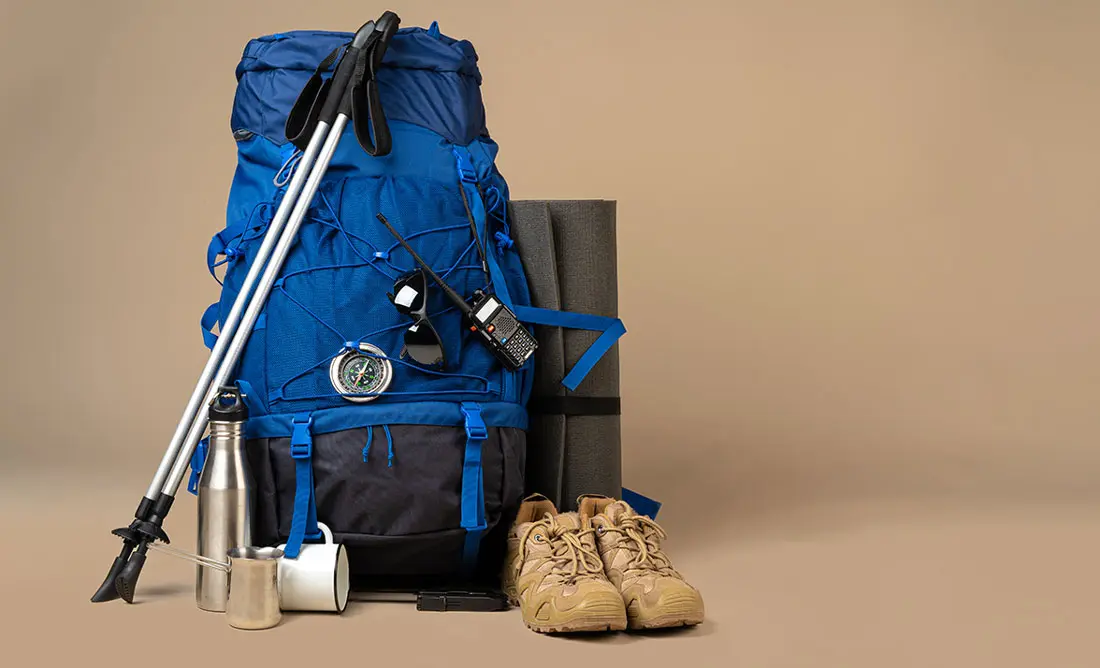
Frequently Asked Questions(FAQ)
To register with TTH, visit our website - www.trekthehimalayas.com and create your account. To create your account you will need to use your email address and fill in all the details, set your unique password and your account is ready to use.
- To book a trek with TTH, you first need to register with us and create an account.
- Choose the trek that you want to do and click on available dates.
- You will land at the login page, fill in the required details.
- Add Participants, choose add-on services click on the Pay now button, choose your preferred payment method, and make the payment. TTH accepts multiple payment options, including credit/debit cards, net banking, and UPI.
- You will receive a confirmation email from TTH with all the necessary details about the trek, including the meeting point, transportation, accommodation, and other important instructions.
- Click Here to watch Video
please send an email to us at info@trekthehimalayas.com or reach out to the numbers provided in the Help and Support section of your Trek Page. We will ensure that your issue is promptly resolved.
To book services such as off-load luggage and transportation, you can find them listed as add-ons. These additional services can be booked at the time of your initial booking. If you miss booking add-ons during the initial reservation, you can log in anytime and easily book 4 days before the departure date add-ons through the platform.
If you have booked the wrong trek or selected the wrong date, don’t worry! You can contact us at +91 9368882322 (Monday to Saturday, 10 AM to 10 PM) or email us at info@trekthehimalayas.com. You can also discuss this with your trek coordinator. Please make sure to inform us at least 10 days before the departure of your trek. Only then can we help you reschedule or arrange another trek for you.
We recommend visiting our "Suggest Me a Trek" page. By filling out the form, our experts will contact you with the best possible trek options based on your preferences and experience level. Alternatively, you can reach out to us via email at info@trekthehimalayas.com or give us a call using the numbers provided on our website for personalized assistance and recommendations.
Family treks differ from regular treks by focusing on ease of difficulty, offering shorter durations for younger participants, Kid-friendly and easily digestible foods, child-friendly activities, maintaining a higher guide ratio for diverse age groups, and implementing additional safety measures for families.
Family Trek with Kids recommendation Only Dayara Bugyal and Chopta Chandrashila Trek.
Minimum age for TTH treks is typically 7 years, though this may vary depending on the specific trek.
Yes, you can take a kids to a high-altitude trek with a parent. Discuss with a trek expert before booking a trek.
- Junior trekkers (below 15 years) should have a company of parents/guardians.
- Trekkers between 15 to 18 years can come solo with the disclaimer form signed by parent/guardian.
- Medical & Disclaimer Form (Mandatory Documents) Click here to download medical and disclaimer form
Physical Fitness: Ensure your child is physically fit. Engage them in regular exercise, outdoor activities, and hikes to build stamina and endurance. Hydration: Emphasize the importance of staying hydrated at high altitudes. Encourage your child to drink water regularly, even if they don't feel thirsty. Proper Nutrition: Provide a well-balanced diet with sufficient carbohydrates for energy and foods rich in iron to prevent altitude sickness. Adequate Sleep: Ensure your child gets enough sleep in the days leading up to the trek. Quality rest is crucial for altitude adaptation. Educate on Altitude Sickness: Teach your child about the symptoms of altitude sickness, such as headache, nausea, and dizziness. Encourage them to communicate any discomfort immediately. Appropriate Clothing and Gear: Dress your child in layers to adjust to changing temperatures. Ensure they have appropriate trekking gear, including sturdy footwear. Positive Mindset: Foster a positive mindset. Encourage your child, and let them know it's okay to take breaks when needed. Medical Check-Up: Schedule a medical check-up before the trek to ensure your child is fit for high-altitude activities. Consult with a healthcare professional about any potential health concerns.
TTH takes special care to provide wholesome and nutritious food for children on treks. Here are some of the foods that are typically served for children:
Breakfast: For breakfast, TTH serves a variety of options like porridge, cornflakes, bread, butter, jam, honey, boiled eggs, omelettes, and pancakes. Children can choose from these options to fuel themselves for the day's trek.
Lunch: For lunch, TTH serves lunch which includes rotis, vegetables, rice, dal, and salad. The rotis are usually made fresh on the trek and are a good source of carbohydrates. The dal and vegetables provide protein and other essential nutrients.
Snacks: TTH provides healthy snacks like fresh fruits, dry fruits, energy bars, cookies, and biscuits to keep the children energized throughout the day.
Dinner: For dinner, TTH serves a hot and wholesome meal which includes soup, rice, dal, vegetables, and a non-vegetarian dish (if requested in advance). Children can also choose from a variety of desserts like custard, jelly, and fruit salad.
Dietary requirements: If a child has any special dietary requirements, TTH can cater to those needs as well. For example, if a child is lactose intolerant or allergic to nuts, the kitchen staff can make arrangements to accommodate those requirements.
Choosing the right trek for a beginner can be a bit overwhelming as there are many factors to consider such as distance, elevation gain, terrain difficulty, weather, and time of year. Here are some tips that can help you choose the right trek for a beginner:
1. Determine fitness level: Assess the fitness level of the beginner to understand their physical capabilities. This will help you select a trek that is challenging but not too difficult.
2. Choose a well-traveled trail: A well-traveled trail will have more amenities such as signposts, water stations, and shelter. It is also safer as there will be other hikers on the trail.
3. Consider the length of the trek: For beginners, it is recommended to start with a shorter trek that can be completed in a day or two. This will help them get acclimatized to trekking and build their confidence.
4. Look for gradual elevation gain: Choose a trek with a gradual elevation gain rather than steep ascents. This will make the trek easier and more enjoyable.
5. Check the weather: Check the weather forecast before selecting a trek. Avoid treks during the monsoon season or winter when the trails can be slippery or dangerous.
6. Research the trail: Read about the trail to get an idea of the terrain, altitude, and difficulty level. This will help you select a trek that is suitable for the beginner.
7. Consult with an expert: If you are unsure about which trek to choose, consult our trek expert Mr. Nitin (+91 70600 59773) between 10 AM to 6 PM (Tuesday - Friday). Mr. Nitin will provide you valuable advice and guidance.
Overall, it is important to choose a trek that is enjoyable, challenging but not too difficult, and suitable for the beginner's fitness level and experience.
It is not recommended for a beginner to choose a difficult Himalayan trek. Trekking in the Himalayas can be physically and mentally challenging, especially if you are not used to the high altitude, steep slopes, and rugged terrain. Choosing a difficult trek without the proper experience, fitness level, and preparation can be dangerous and put you at risk of altitude sickness, injury, and other hazards.
If you are a beginner, it is recommended to start with an easier trek and gradually build up your skills and experience. This will help you understand the challenges of trekking in the Himalayas, and also prepare you physically and mentally for a more difficult trek in the future. It is also important to choose a trek that matches your fitness level, experience, and interest.
There is no specific age limit for a beginner trekker. However, it is important to consider your physical fitness, health condition, and personal interests before embarking on a trek. Trekking in the Himalayas can be physically and mentally demanding, and requires a certain level of physical fitness and endurance.
If you have any pre-existing medical conditions or are above a certain age, it is recommended to consult with a doctor before embarking on a trek. It is also important to listen to your body and take breaks as needed during the trek to prevent exhaustion or injury.
We recommend visiting our "Suggest Me a Trek" page. By filling out the form, our experts will contact you with the best possible trek options based on your preferences and experience level. Alternatively, you can reach out to us via email at info@trekthehimalayas.com or give us a call using the numbers provided on our website for personalized assistance and recommendations.
Yes, you can join the trek. We have fixed departure groups where you can simply book your trek and we will take care of curating a group.
Before you start the trek, it is recommended that you make all the necessary phone calls as during the trek you may or may not receive network coverage, once you come back to the Base Camp, you can reconnect with your family via phone once again. You can share your trek coordinator contact detail with your family members to get the latest updates about your trek batch.
At TTH, we provide wholesome and nutritious meals during the trek. The food is vegetarian and includes a variety of dishes such as rice, dal, vegetables, chapati, paratha, pasta, noodles, and soup. We also offer snacks such as biscuits, and salty, and dry fruits during the trek. Special dietary requirements such as vegan, gluten-free, or Jain food can also be arranged if informed in advance.
If you are allergic to some foods, you need to let us know in advance so that we can make arrangements accordingly.
TTH is a trekking company that prioritizes the safety of all its participants, including women trekkers. We have a comprehensive safety system in place, which includes a dedicated team of experienced and trained trek leaders and support staff who are equipped to handle emergency situations and provide first aid.
TTH also takes specific measures to ensure the safety and comfort of women trekkers. They have a separate tent accommodation for women trekkers, female trek leaders, and support staff. They also provide separate toilet facilities for women and encourage a safe and respectful environment for all trekkers.
Moreover, TTH has a strict policy against any kind of harassment and has a zero-tolerance policy towards such incidents. They have a designated Internal Complaints Committee (ICC) to investigate and address any complaints related to harassment or misconduct. Overall, TTH has a good reputation for safety and responsible trekking practices, and women can feel comfortable and safe while trekking with them.
In case you are the only women in the group, we provide a single sleeping arrangement. Also, during the trek, the trek leader will always remain by your side to provide optimum safety and reassurance.
You can reach out to the trek coordinator to inquire about the number of female trekkers and their respective states who have booked the trek. Please note that the trek coordinator cannot disclose personal details of any trekker. Once you've confirmed your booking, a WhatsApp Group will be created for all the trekkers in your batch. This allows you to connect with fellow trekkers before the trek begins.
While many of our treks are led by female trek leaders, however, it is not possible to know which trek leader is assigned to which group. But nonetheless, whether the trek leader is male or female you can be completely assured of your safety and security with us.
Yes, it is possible to trek with periods. However, it is important to take some extra precautions and preparations to ensure a comfortable and safe trekking experience. Here are some tips that can help you trek during your period:
1. Use menstrual hygiene products that you are comfortable with, such as tampons, pads, or menstrual cups. It is recommended to carry enough supplies for the entire duration of the trek.
2. Pack wet wipes, hand sanitizer, and plastic bags to dispose of used hygiene products.
3. Wear comfortable and breathable clothing that allows for easy movement and reduces friction. Avoid wearing tight or restrictive clothing that can cause discomfort.
4. Carry pain relief medication, such as ibuprofen or acetaminophen, in case of menstrual cramps.
5. Stay hydrated and maintain a balanced diet to support your energy levels and overall health.
6. Take breaks as needed and listen to your body. If you feel uncomfortable or experience any unusual symptoms, seek medical attention immediately. It is also recommended to consult with a doctor before going on a trek during your period, especially if you have a pre-existing medical condition or are taking medication.
By taking necessary precautions and being prepared, you can have a safe and comfortable trekking experience even during your period. We provide proper disposal facilities for sanitary pad disposal during the trek.
We offer three person tents with twin-sharing for optimum comfort. A woman trekker will share a tent with another woman trekker and if you are the only woman in the group, you will be given a single accommodation for your comfort and privacy.
Yes, we do provide gears on rent. You can book it using you TTH account directly.
Mountaineering qualified Experienced and first aid certified Trek Leader, First Aid Certify local guide, Cook, helpers and supporting staff.
People suffering from Bronchitis, Asthma, High blood pressure, Epilepsy (got faints), TB , Heart problem or on higher BMI side are strictly not allowed to go on any Himalayan trek. Apart from this if you had any medical history, please let us know.
No. Alcohol and smoking isn’t allowed while on trek. It is totally misconception that it will keep you warm. Your body need to acclimatize properly and for that eat properly and drink enough water; these things will keep you warm.
Toilet tents provide a convenient solution for answering nature's call in the great outdoors. Dry toilets, in particular, offer a highly sanitary approach. By digging a pit and utilizing mud and a shovel, you can easily cover up your waste. This method ensures cleanliness and hygiene while camping or exploring in the forest.
Remember to pack essential toiletries to complete your outdoor bathroom kit and maintain proper personal hygiene during your adventures. With these practices in place, you can enjoy nature while also respecting it.
Layer Up From Head To Toe
Eat Full Meals, never sleep empty stomach
You can keep warmee (if you’re more susceptible to cold).
Use sleeping bag in right way and don’t leave free space in sleeping bag.
For upper body
– Thermal layer
– T-shirt (full-sleeves)
– Fleece T-shirt (for extreme colds)
– Fleece layer
– Thick Jacket/Down Jacket
– Waterproof or Windproof layer (outermost layer, when it is snowing or raining)
- For Lower Body
– Thermal layer
– Hiking pants (normal) or Winter hiking pants
Based on how warm you feel you can skip any of the above layers. Your outer later should be windproof since it is windy at high altitude.
The idea behind layering is that the more insulation you have the less cold you feel, and instead of wearing a very thick jacket if you wear multiple layers, your body will be better insulated against the cold.
Yes, we provide micro spikes and gaiters, if required.
Mandatory documents: 2 xerox of ID having address (addhar card/driving license), 2 Passport size photographs, hard copy Medical form signed & sealed by doctor, disclaimer form sign by trekker and high altitude insurance.
No. We don’t but we can suggest you good hotel/Stay nearby pick up location.
Yes, trekker must carry 2 water bottles 1 litre each so they can refill it at campsite for drinking and keep themselves hydrate.
You should buy shoes which has these three features –Good grip, Ankle Support and additional water resistant layers. Generally, we advise Quechua Trek 100, MH 500 and MH 100.
No one is forced to go on. There is always enough staff to split the party according to need and regroup later at the camp. Most people have no trouble reaching the highest campsite. If some members decide not to climb the final distance they can wait for the climbers to come back down the same way or take a lateral path to the descent route.
Bali Pass Trek is an 8 days trek with Trek The Himalayas while the total trekking distance you cover during this trek is around 56 kilometers.
The Bali Pass Trek is definitely worth every bit of effort you put into it. While the trail can be tough at times and will test your endurance, strength, and patience, the rewards are truly worth it all. From peaceful forests and beautiful meadows to stunning views of snow-covered peaks, every step of the journey has something to be appreciated. The calmness of nature, the fresh mountain air, and the feeling of being far away from the busy world make the whole experience even more meaningful.
The Bali Pass Trek is a beautiful trekking route in the state of Uttarakhand.
The Bali Pass Trek Itinerary with Trek The Himalayas is as follows:
Day-1: Dehradun to Sankri (Drive)
Day-2: Sankri to Seema via Dhatmeer
Day-3: Seema to Devsu Bugyal
Day-4: Devsu Bugyal to Ruinsara Tal
Day-5: Ruinsara Tal to Odari
Day-6: Odari to Bali col camp
Day-7: Bali col camp to Lower Dhamni via Bali Pass
Day-8: Lower Dhamni to Janki Chatti and drive to Dehradun
The Bali Pass Trek is one of the most scenic and exciting treks in the Indian Himalayas. Some of the major highlights include crossing the high-altitude Bali Pass itself, walking along the beautiful Narma Kandi ridge and visiting the peaceful Ruinsara Tal, a crystal-clear alpine lake surrounded by mountains. Camping at Devsu Bugyal, a lush green meadow surrounded by forests, is a calming and memorable experience. One of the best parts of this trek is the wide, panoramic views of the snow-covered Himalayan peaks. Along the way, you’ll also pass through remote villages like Gangad, Dharkot, and Dhatmir, where you can experience the simple and rich culture of mountain life. This mix of adventure, natural beauty, and local culture makes the Bali Pass trek truly special.
The Maximum altitude reached during the Bali Pass trek is 16,200 ft. at the Bali Pass itself.
Yes, permits are required for the Bali Pass trek, as it passes through protected areas. These permits help regulate footfall and ensure the conservation of the region’s biodiversity. However, you don’t have to worry about arranging them yourself. If you are trekking with an experienced organization like TTH (Trek The Himalayas), all necessary permits, forest permissions, and related fees are taken care of and included in your trek package. This allows you to enjoy the trek without the stress of handling logistics.
For the Bali Pass Trek, you need to be in good physical health. You should have the stamina to cover 5 km in 30 minutes comfortably, or be able to jog 10 km in 70 minutes without feeling overly tired. If you prefer cycling, you should be able to cycle 20 km in 55 minutes with ease. This level of fitness will help you tackle the trek’s moderate to challenging sections more comfortably and enjoy the experience.
Yes, backpack offloading service is available during the Bali Pass Trek. This allows you to have a lighter load while trekking, making your journey more comfortable.
Yes, the Bali Pass Trek can be suitable for first-time trekkers, but it’s important to have a basic level of fitness. While the trek is manageable for beginners, some sections are moderately challenging, so being prepared physically will make the experience more enjoyable. If you’re new to trekking, it’s a good idea to start training with some shorter hikes to build stamina and strength.
The nearest ATM for the Bali Pass Trek is located in Purol. It's a good idea to withdraw cash from there, as ATM facilities are limited in the villages along the trek. Make sure to carry enough money for your trek, as there are no ATMs available during the hike.
In September and October, the Bali Pass Trek offers an amazing experience during the post-monsoon months. The trail is fresh and green after the rains, with crisp autumn air making the trek even more enjoyable. The skies are clearer, providing excellent visibility of the peaks and valleys. You'll also get to see the vibrant autumn colors along the trail, adding to the beauty of the surroundings. The post-monsoon freshness combined with the stunning views makes trekking in these months truly special.
The best time to book the Bali Pass Trek is 2 to 3 months before your planned trekking date. This gives you enough time to prepare, ensures availability on your preferred dates, and helps you avoid any last-minute rush or hassle. Early booking also allows you to plan your travel and gear more smoothly.
Yes, acclimatization is very important for the Bali Pass Trek, as it is a high-altitude trek. Trek The Himalayas’ itinerary is carefully designed to help you acclimatize gradually as you trek. To make it even more effective, there are short acclimatization walks around the campsite, which help your body adjust better to the altitude and reduce the chances of altitude sickness.
To prepare well for the Bali Pass Trek, it's important to work on your physical fitness, stamina, and gear readiness. This challenging high-altitude trek demands good cardiovascular endurance and leg strength to handle long walking hours, steep climbs, and tricky descents.
Here’s how to match the recommended fitness level for the trek:
- You should be able to run 5 km in 30 minutes without feeling overly exhausted, or jog 10 km in 70 minutes at a steady pace.
- If you prefer cycling, you should comfortably cover 20 km in 55 minutes without too much strain.
- Regular training that includes a mix of running, cycling, stair climbing, and strength exercises (especially for legs and core) will help you prepare better.
- Also, try to do a few hikes with a backpack to simulate actual trek conditions.
Apart from Bali Pass, there are several other high-altitude treks in India that offer a mix of adventure, scenic beauty, and a true test of endurance. Some popular ones include the Pin Parvati Pass trek, Goechala, Yunam Peak Expedition, Friendship Peak Expedition, and the Kedartal trek. These treks take you to elevations well above 14,000 feet, offering amazing views of snow-covered peaks, glaciers, and alpine landscapes. Each of them provides a thrilling experience and is perfect for trekkers looking to explore the raw beauty of the Himalayas at high altitudes.
Bali Pass Trek package is designed to provide a well-organised and comfortable journey, ensuring that every trekker can enjoy trekking without worrying about the logistics. The package includes accommodation throughout the journey, offering comfortable stays at different points of the trek.
Meals and all necessary transportation is covered, including drives to and from key locations.
For the trekking experience, the package provides high-quality trek equipment, ensuring safety and comfort during the journey. A well-equipped first aid kit is also included, along with medical assistance in case of emergencies. To make the trek smoother and more enriching, a dedicated support team accompanies travelers. This team includes experienced local guides who are familiar with the region, a base camp manager to oversee logistics, and a professional trek leader to ensure safety and coordination throughout the journey. With all these inclusions, the package is designed to offer a hassle-free, safe, and memorable experience for every trekker.
Click here, to check the Bali Pass Trek price.
.webp)
.webp)
.webp)
.webp)
.webp)
.webp)
.webp)
.webp)
.webp)
.webp)
